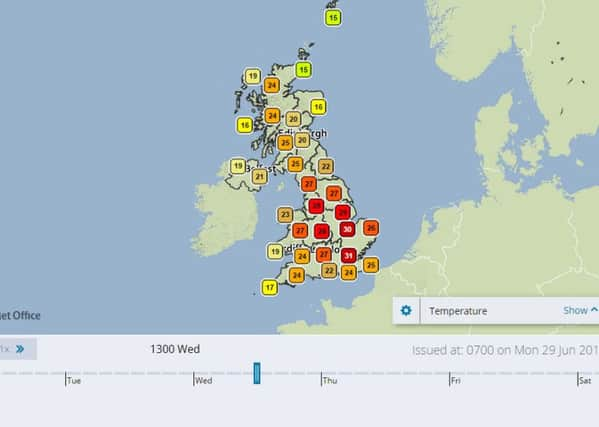Delays on the railways as England becomes too hot for trains


Temperatures of up to 30c are forecast for the East of England and the East Midlands this week. The Met Office said there was an “80% probability” of heatwave conditions from noon today, Tuesday, until 6am on Thursday in parts of England.
The heat is predicted to be so intense that Network Rail has imposed a speed restriction on some services today to stop the rails from buckling.
Advertisement
Hide AdAdvertisement
Hide Ad“As rails are made out of steel, they expand as they heat up and are subject to strong compression,” Network Rail said on its website.
“This expansion has to be managed to reduce the risk of track buckling.
“If the track does buckle, the line must be closed and the track repaired before services can resume, causing considerable disruption.
“Usually, these repairs can’t be done until the temperature of the rails has dropped.
Advertisement
Hide AdAdvertisement
Hide Ad“If a section of track is judged to be at risk,we introduce local speed restrictions - slower trains exert lower forces on the track and reduce the chance of buckling.”
AA spokesman Paul Watters advised motorists to carry water on long journeys and prepare for extreme temperatures to soften road surfaces.
He said: “Roads start to soften at about 27℃ and if the hot weather lasts they absorb the heat a bit like a storage heater.
“Road surfaces can become a bit like dough and this can lead to cracks and the surface of the road can start to give.”
Advertisement
Hide AdAdvertisement
Hide AdTemperatures are soar as a swathe of roasting air sweeps north from northern France and Spain.
There is also a ‘Very High’ pollen count forecast on Tuesday and Wednesday.
The forecast triggered a ‘Level 2’ alert with the Met Office warning: “Heatwaves can be dangerous, especially for the very young or very old or those with chronic disease.”
The Level 2 alert - calling for “alert and readiness” - is the third-highest warning that can be issued.
Advertisement
Hide AdAdvertisement
Hide AdGraham Bickler of Public Health England said: “There is considerable evidence that heatwaves are dangerous and can kill.
“In the 2003 heatwave, there were 2,000 to 3,000 excess deaths [more than usual] in England. Across Europe, there were around 30,000 excess deaths.”
The Met Office said: “Temperatures are expected to build on Tuesday and into Wednesday, with the hottest day of the year so far expected on successive days this working week.”
Wednesday is likely to be the hottest day of the year so far, with temperatures soaring to 33℃ (91F).
Advertisement
Hide AdAdvertisement
Hide AdTemperatures will be similar to those in Rome and Florida, and higher than in Rio de Janeiro.
A Met Office spokesman added temperatures should drop again on Thursday when severe thunderstorms are likely to hit central and western parts of the country, before climbing again ahead of the weekend.
Met Office Heat-health watch Level 2 advice: Heatwaves can be dangerous, especially for the very young or very old or those with chronic disease. Advice on how to reduce the risk either for yourself or somebody you know can be obtained from NHS Choices at www.nhs.uk/summerhealth, NHS 111 or from your local chemist.
Clive James, of St John Ambulance, added: “Extreme heat can be dangerous, particularly for the very young and old, but by being prepared you can spot the early warning signs and potentially be the difference between life and death in an emergency.
Advertisement
Hide AdAdvertisement
Hide Ad“Heat exhaustion and heat stroke are the most serious problems that can develop when the mercury soars so it’s essential that people can spot the signs, such as headache and dizziness, and get somewhere cool and rehydrated as soon as possible.”